Multi-Step Approach for Fast Calculation of Magnetic Field in Transformer Tank Shields
Abstract
:1. Introduction
2. Vertical Tank Shields
3. Calculation of Magnetic Field in Tank Shields
3.1. Standard FEM Models
- Simcenter MAGNET 2020.1 is used for all 3D FEM calculations.
- ◦
- Magnetostatic problems are formulated using the scalar magnetic potential.
- ◦
- Second-order tetrahedral elements are used.
- ◦
- In this paper, the windings in the 3D model are current-driven.
- FEMM 4.2 [23] is used for all 2D FEM calculations.
- ◦
- Magnetostatic and quasi-magnetostatic problems in this software are formulated using the vector magnetic potential. In the case of 2D models, the vector magnetic potential has only one vector component, which is perpendicular to the 2D plane. Therefore, it is denoted by the letter A as a scalar throughout the paper.
- ◦
- First-order triangular elements are used.
- ◦
- In this paper, two types of sources are used in 2D FEM models:
- ▪
- In models that include windings, the currents are defined in these windings.
- ▪
- In other models that do not include windings, the magnetic field is imposed by defining a vector magnetic potential, as explained later in the paper (Section 3.4).
- ◦
- In this paper, the pre-processing and post-processing are scripted using MATLAB R2020b.
3.2. Multi-Step Calculation
- A single-phase axisymmetric 2D FEM model that includes the windings and core is used (Step 1 in Figure 2 and more detailed explanation in Figure 3a).
- ◦
- ◦
- The method of mirror images is used to simulate permeable tank shields.
- ◦
- This model is used to calculate the magnetic field on the surface of the tank shields (Step 3 in Figure 2), which is explained in detail in Section 3.3.
- A 2D FEM model in the horizontal cross-section, with a detailed geometry of tank shields, is used to calculate the weight factors (Step 4 in Figure 2). These factors determine how much of the magnetic flux, calculated with a quasi-3D model, enters the particular tank shield stack. This step is explained in detail in Section 3.5.
- A 2D FEM model in a vertical cross-section with a non-linear tank shield calculates the vertical distribution of the magnetic flux density within the tank shield stack (Step 5 in Figure 2). This step must be carried out for every single stack. It is explained in detail in Section 3.6.
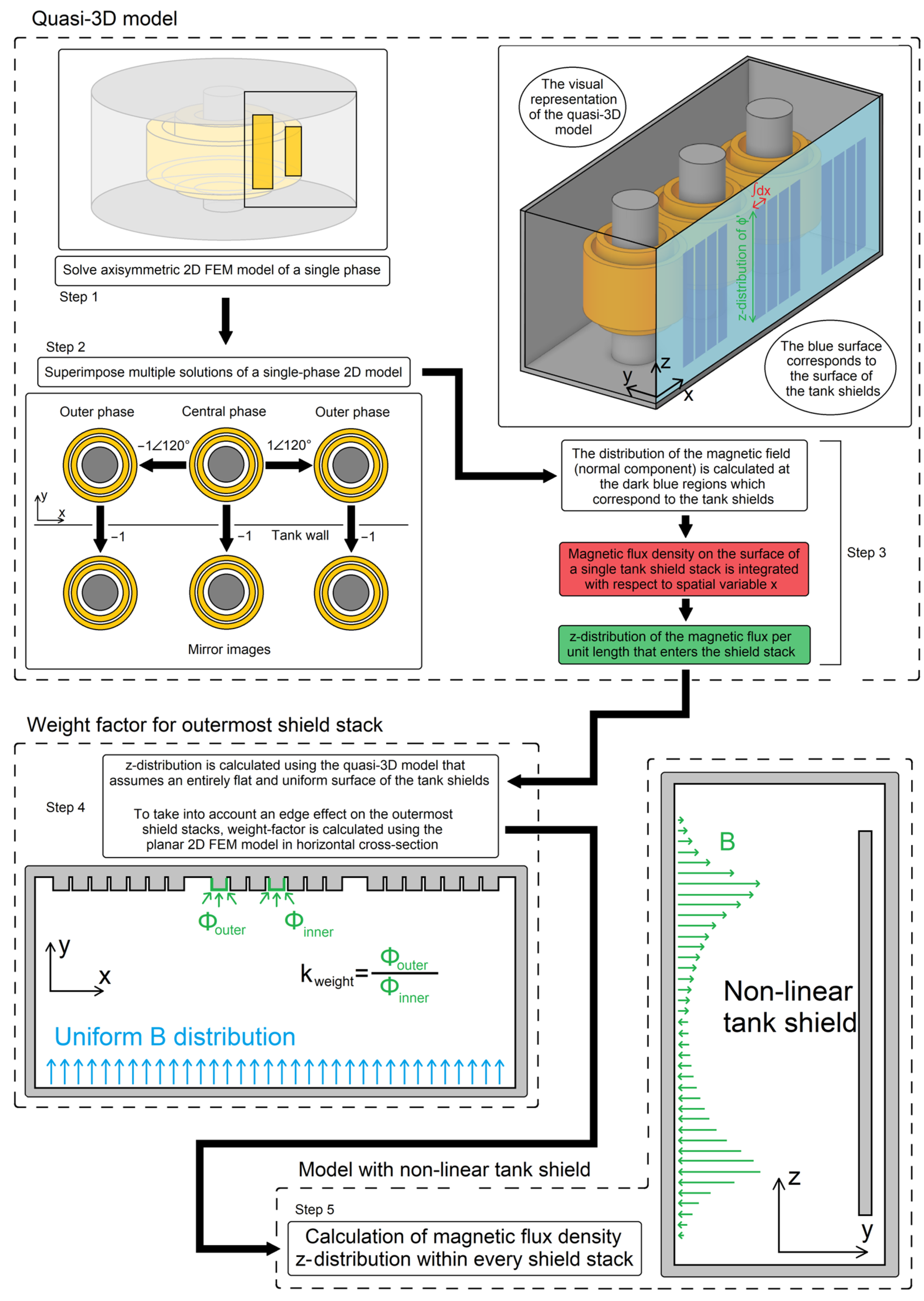
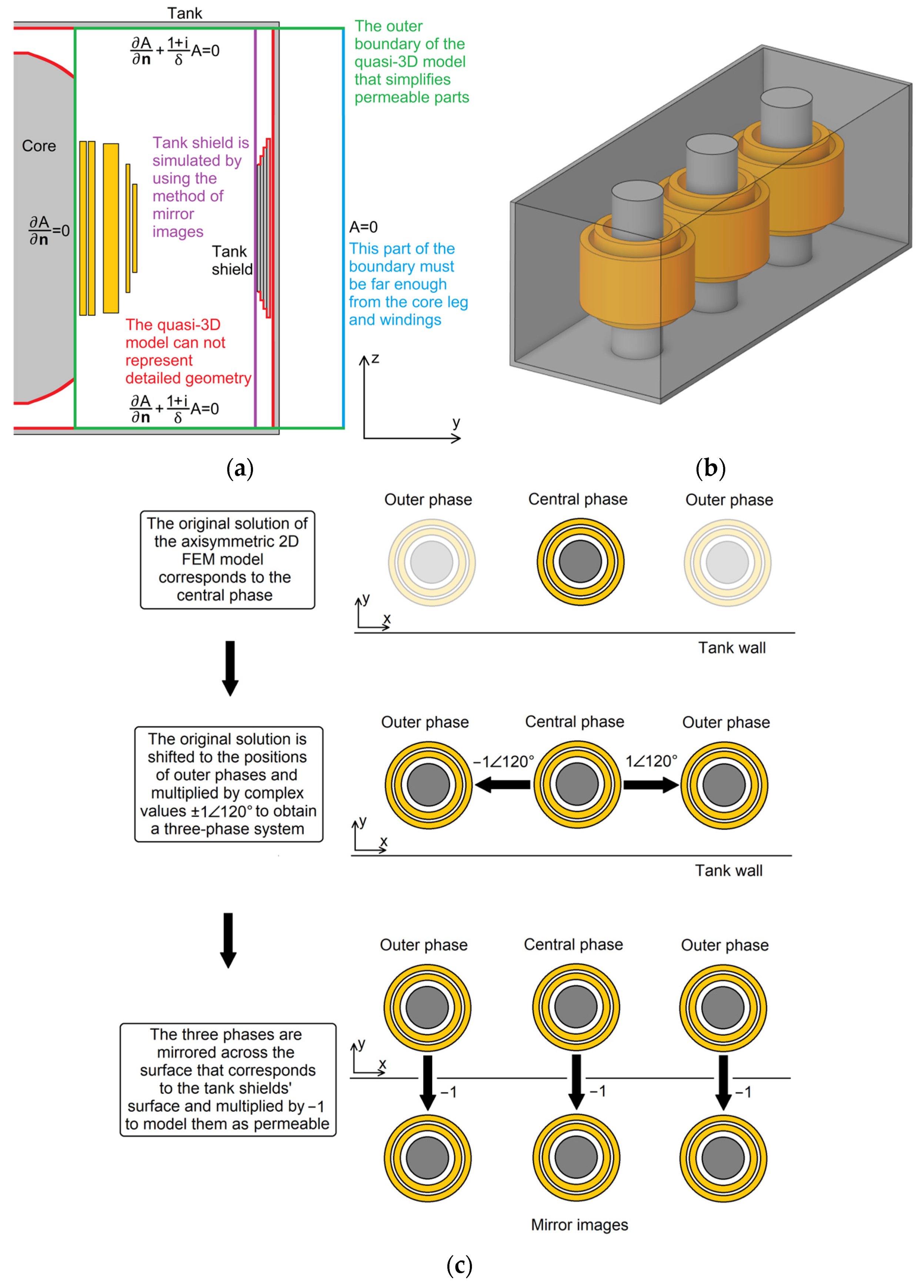
3.3. Quasi-3D Model
3.4. Imposing an Arbitrary Magnetic Flux Density Distribution in a 2D FEM Model
3.5. Calculation of the Weight Factors Using the Horizontal 2D FEM Model
3.6. Calculation of Magnetic Flux Density within the Tank Shield Using the Vertical 2D FEM Model
4. Case Study
5. Discussion
6. Conclusions
Author Contributions
Funding
Data Availability Statement
Conflicts of Interest
References
- Olivares-Galván, J.C.; Georgilakis, P.S.; Ocon-Valdez, R. A Review of Transformer Losses. Electr. Power Compon. Syst. 2009, 37, 1046–1062. [Google Scholar] [CrossRef]
- Kassi, K.S.; Fofana, I.; Meghnefi, F.; Yeo, Z. Impact of local overheating on conventional and hybrid insulations for power transformers. IEEE Trans. Dielectr. Electr. Insul. 2015, 22, 2543–2553. [Google Scholar] [CrossRef]
- Song, Z.; Wang, Y.; Mou, S.; Wu, Z.; Zhu, Y.; Xiang, B.; Zhou, C. Tank losses and magnetic shunts in a three phase power transformer. In Proceedings of the 2011 International Conference on Electrical Machines and Systems, Beijing, China, 20–23 August 2011; pp. 1–4. [Google Scholar] [CrossRef]
- Li, L.; Fu, W.N.; Ho, S.L.; Niu, S.; Li, Y. Numerical Analysis and Optimization of Lobe-Type Magnetic Shielding in a 334 MVA Single-Phase Auto-Transformer. IEEE Trans. Magn. 2014, 50, 1–4. [Google Scholar] [CrossRef]
- Yongbin, C.; Junyou, Y.; Hainian, Y.; Renyuan, T. Study on eddy current losses and shielding measures in large power transformers. IEEE Trans. Magn. 1994, 30, 3068–3071. [Google Scholar] [CrossRef]
- Moghaddami, M.; Sarwat, A.I.; de Leon, F. Reduction of Stray Loss in Power Transformers Using Horizontal Magnetic Wall Shunts. IEEE Trans. Magn. 2017, 53, 1–7. [Google Scholar] [CrossRef]
- Dasara, S.; Mishra, V.P. Shielding measures of power transformer to mitigate stray loss and hot spot through coupled 3D FEA. High Volt. 2017, 2, 267–273. [Google Scholar] [CrossRef]
- Al-Abadi, A.; Gamil, A.; Schatzl, F. Optimization of Magnetic Shunts Towards Efficient and Economical Power Transformers Design. In Proceedings of the 21st International Symposium on High Voltage Engineering, ISH 2019, Budapest, Hungary, 26–30 August 2019; Lecture Notes in Electrical Engineering. Springer: Cham, Switzerland, 2020; pp. 15–26. [Google Scholar] [CrossRef]
- Tsili, M.A.; Kladas, A.G.; Georgilakis, P.S.; Souflaris, A.T.; Paparigas, D.G. Geometry optimization of magnetic shunts in power transformers based on a particular hybrid finite-element boundary-element model and sensitivity analysis. IEEE Trans. Magn. 2005, 41, 1776–1779. [Google Scholar] [CrossRef]
- Hernandez, C.; Arjona, M.A.; Sturgess, J.P. Optimal Placement of a Wall-Tank Magnetic Shunt in a Transformer Using FE Models and a Stochastic-Deterministic Approach. In Proceedings of the 2006 12th Biennial IEEE Conference on Electromagnetic Field Computation, Miami, FL, USA, 30 April–3 May 2006; p. 468. [Google Scholar] [CrossRef]
- Jurković, Z.; Jurišić, B.; Župan, T. Multi-step approach for fast calculation of magnetic field in power transformer yoke shunt. Electr. Power Syst. Res. 2023, 221, 109407. [Google Scholar] [CrossRef]
- Jurković, Z.; Jurišić, B.; Župan, T. Fast Hybrid Approach for Calculation of Losses in Outer Packages of Transformer Core due to Perpendicular Stray Flux. IEEE Trans. Magn. 2021, 57, 1–4. [Google Scholar] [CrossRef]
- Liu, C.; Ruan, J.; Wen, W.; Gong, R.; Liao, C. Temperature rise of a dry-type transformer with quasi-3D coupled-field method. IET Electr. Power Appl. 2016, 10, 598–603. [Google Scholar] [CrossRef]
- Schlesinger, R.; Ewald, T.; Biela, J. Analytical Hybrid Quasi-3D Transformer Leakage Inductance Model. IEEE Trans Power Electron. 2023, 38, 5092–5106. [Google Scholar] [CrossRef]
- Jurković, M.; Žarko, D. Core-type transformer short-circuit voltage calculation using conformal mapping. IET Electr. Power Appl. 2020, 14, 2422–2430. [Google Scholar] [CrossRef]
- Jurković, M.; Žarko, D. Calculation of current distribution in parallel-connected transformer winding sections in the case of asymmetric magnetic field during short-circuit test. Electr. Power Syst. Res. 2022, 210, 108141. [Google Scholar] [CrossRef]
- Zhao, H.; Chau, K.T.; Yang, T.; Song, Z.; Liu, C. A Novel Quasi-3D Analytical Model for Axial Flux Motors Considering Magnetic Saturation. IEEE Trans. Energy Convers. 2022, 37, 1358–1368. [Google Scholar] [CrossRef]
- Rostami, N.; Rostami, M. Analysis of AFPM machines with cylindrically shaped magnets using quasi-3D method. COMPEL Int. J. Comput. Math. Electr. Electron. Eng. 2017, 36, 1168–1183. [Google Scholar] [CrossRef]
- Lv, G.; Zhou, T.; Zeng, D. Quasi-3D Analytic Method of the Single-Sided Linear Induction Motor With the Ladder Secondary. IEEE Trans. Ind. Electron. 2021, 68, 11817–11825. [Google Scholar] [CrossRef]
- Hemeida, A.; Lehikoinen, A.; Rasilo, P.; Vansompel, H.; Belahcen, A.; Arkkio, A.; Sergeant, P. A Simple and Efficient Quasi-3D Magnetic Equivalent Circuit for Surface Axial Flux Permanent Magnet Synchronous Machines. IEEE Trans. Ind. Electron. 2019, 66, 8318–8333. [Google Scholar] [CrossRef]
- Wen, X.; Yao, R.; Tegopoulos, J.A. Calculation of forces on the stator end windings of turbogenerator by the transient quasi-3D method. IEEE Trans. Magn. 1996, 32, 1669–1672. [Google Scholar] [CrossRef]
- Kulkarni, S.V.; Khaparde, S.A. Transformer Engineering, 2nd ed.; CRC Press: Boca Raton, FL, USA, 2017. [Google Scholar] [CrossRef]
- Meeker, D. Finite Element Method Magnetics, Version 4.2. Available online: https://www.femm.info (accessed on 5 September 2023).
- Van Bladel, J. Magnetostatic Fields at an Iron-Air Boundary. Am. J. Phys. 1961, 29, 732–736. [Google Scholar] [CrossRef]
- Yuferev, S.; Ida, N. Selection of the surface impedance boundary conditions for a given problem. IEEE Trans. Magn. 1999, 35, 1486–1489. [Google Scholar] [CrossRef]
- Lambert, M.; Sirois, F.; Martinez-Duro, M.; Mahseredjian, J. Analytical Calculation of Leakage Inductance for Low-Frequency Transformer Modeling. IEEE Trans. Power Deliv. 2013, 28, 507–515. [Google Scholar] [CrossRef]
- Moghaddami, M.; Moghadasi, A.; Sarwat, A.I. An algorithm for fast calculation of short circuit forces in high current busbars of electric arc furnace transformers based on method of images. Electr. Power Syst. Res. 2016, 136, 173–180. [Google Scholar] [CrossRef]

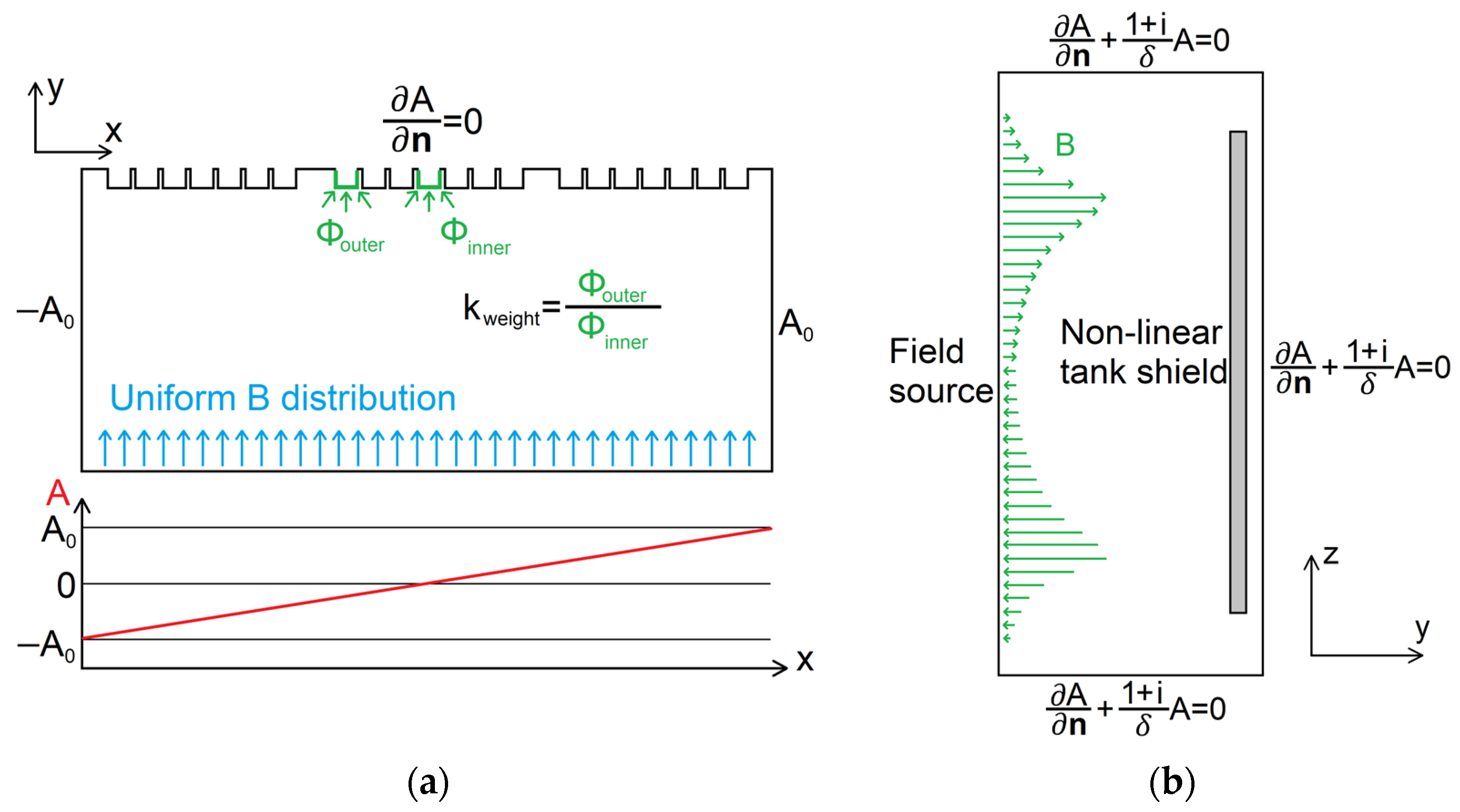
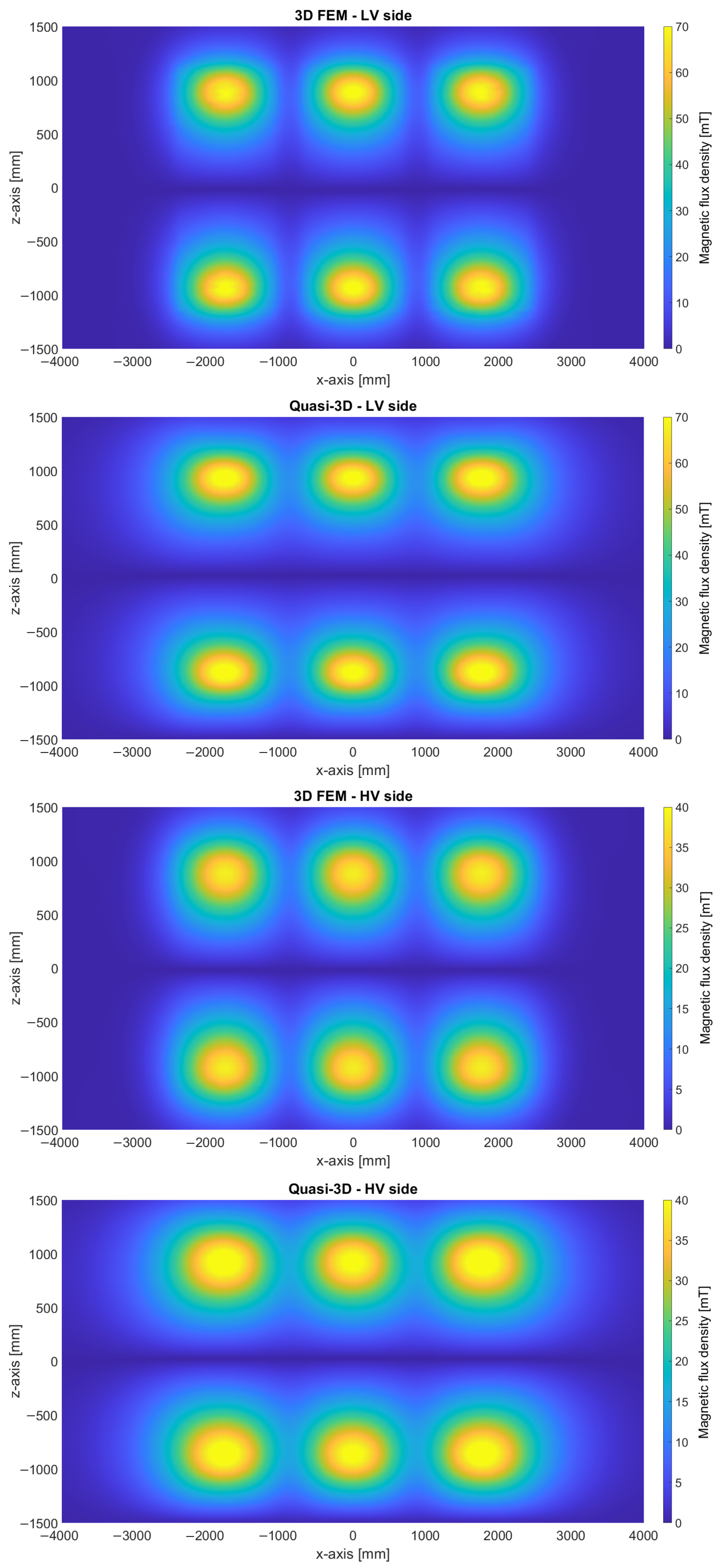
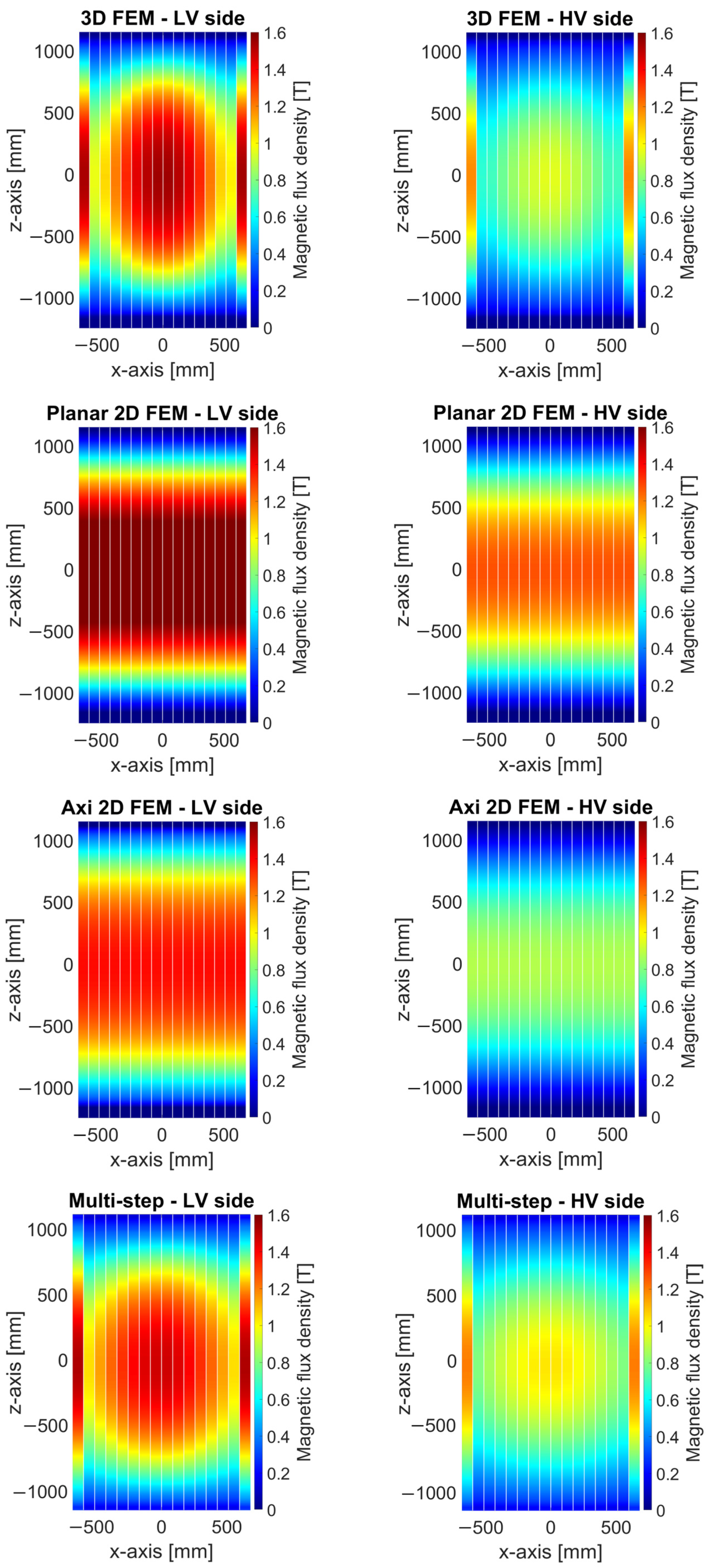
| Parameter | Value |
|---|---|
| Rated power | 300 MVA |
| Frequency | 50 Hz |
| Voltage level | 220/20 kV |
| Short-circuit impedance | 14% |
| Core type | 3–2 |
| Distribution | NRMSE [%] | |||
|---|---|---|---|---|
| The distribution of the magnetic flux density in the vicinity of the tank shields | LV | 5.0 | ||
| HV | 7.7 | |||
| The distribution of the magnetic flux density within the shield | Planar 2D FEM | LV | 22.3 | |
| HV | 24.8 | |||
| Axisymmetric 2D FEM | LV | 12.2 | ||
| HV | 10.0 | |||
| Multi-step approach | LV | 6.0 | ||
| HV | 9.5 | |||
| 2D FEM [T] | ε [%] | |||
| The maximum value of the magnetic flux density within the shield3D FEM:LV: 1.55 THV: 1.19 T | Planar 2D FEM | LV | 1.76 | 14.0 |
| HV | 1.27 | 7.0 | ||
| Axisymmetric 2D FEM | LV | 1.38 | −10.5 | |
| HV | 0.88 | −26.2 | ||
| Multi-step approach | LV | 1.52 | −1.4 | |
| HV | 1.20 | 1.2 | ||
| Model | Time [min:s] | Time Reduction [%] |
|---|---|---|
| Planar 2D FEM | 00:01 | −99.97 |
| Axisymmetric 2D FEM | 00:01 | −99.97 |
| Multi-step approach | 00:28 | −99.19 |
| 3D FEM | 57:32 | 0 |
Disclaimer/Publisher’s Note: The statements, opinions and data contained in all publications are solely those of the individual author(s) and contributor(s) and not of MDPI and/or the editor(s). MDPI and/or the editor(s) disclaim responsibility for any injury to people or property resulting from any ideas, methods, instructions or products referred to in the content. |
© 2024 by the authors. Licensee MDPI, Basel, Switzerland. This article is an open access article distributed under the terms and conditions of the Creative Commons Attribution (CC BY) license (https://creativecommons.org/licenses/by/4.0/).
Share and Cite
Jurković, Z.; Jurišić, B.; Župan, T. Multi-Step Approach for Fast Calculation of Magnetic Field in Transformer Tank Shields. Energies 2024, 17, 1378. https://doi.org/10.3390/en17061378
Jurković Z, Jurišić B, Župan T. Multi-Step Approach for Fast Calculation of Magnetic Field in Transformer Tank Shields. Energies. 2024; 17(6):1378. https://doi.org/10.3390/en17061378
Chicago/Turabian StyleJurković, Zvonimir, Bruno Jurišić, and Tomislav Župan. 2024. "Multi-Step Approach for Fast Calculation of Magnetic Field in Transformer Tank Shields" Energies 17, no. 6: 1378. https://doi.org/10.3390/en17061378
APA StyleJurković, Z., Jurišić, B., & Župan, T. (2024). Multi-Step Approach for Fast Calculation of Magnetic Field in Transformer Tank Shields. Energies, 17(6), 1378. https://doi.org/10.3390/en17061378









